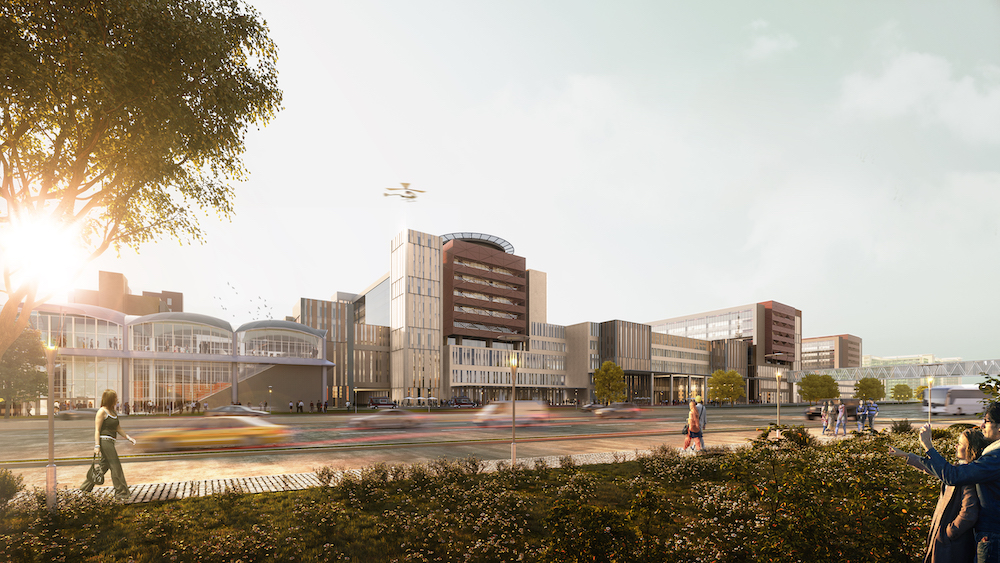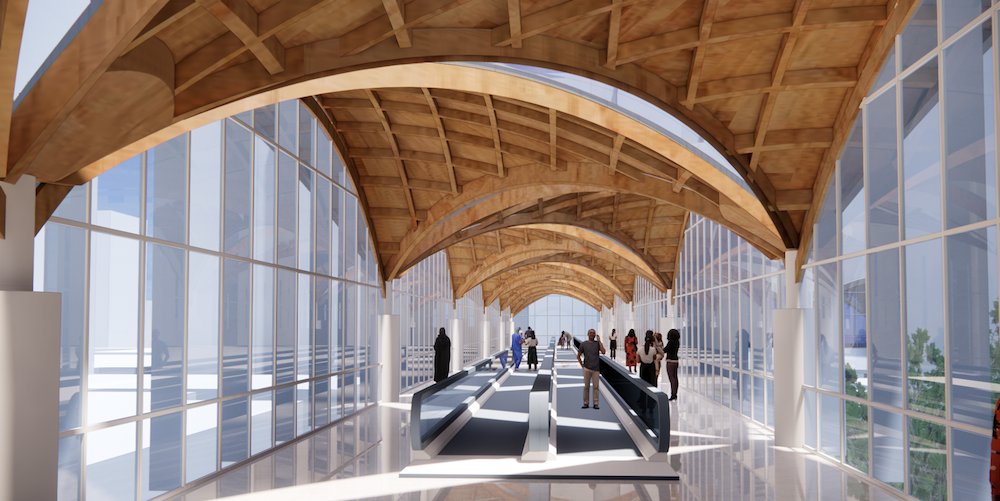Healthcare / Teaching
The AIIMS, New Delhi, redevelopment mega-project
By Greg Mare, FAIA, ACHA, and Dr Randeep Guleria, MD, DM | 16 Sep 2024 | 0
This paper invites a closer examination of the All India Institute for Medical Sciences’ transformative journey, showcasing how the amalgamation of cutting-edge design principles and sustainable practices resolved client requirements and paved the way for self-learning health systems on a monumental scale.
Abstract
The imperative to address outdated infrastructure, rapidly growing demands, and the integration of advanced medical technology prompted the All India Institute for Medical Sciences (AIIMS), New Delhi to embark on a transformative journey.
Situated on a 194-acre campus, originally suburban but now engulfed by urban development, AIIMS seized an opportunity for change – to become an Indian Green Building Council (IGBC) platinum-rated sustainable medical university. Encompassing healthcare, education, and research components, the redevelopment totals 1.51 million square metres of newly built space. It includes 3000-plus inpatient beds; a 300-bed emergency department; 90-plus operating theatres; a new outpatient clinic tower; expanded teaching facilities; and state-of-the-art infrastructure. The campus not only caters to the medical requirements of New Delhi but also serves patients from across India and internationally.
The sheer magnitude of change necessitated that capitalising on collective knowledge and global expertise. The collaboration spanned medical, academic and laboratory planners, urban designers, architects, engineers, and sustainability experts from the US, China, Australia, and India, bringing insights and innovations from diverse perspectives and ensuring a comprehensive approach, informed by a toolkit of best practices, developed from experience on three continents. Seamless international integration enabled work to run around the clock, handing off between time zones, as a truly fast-track initiative.
The project employs best practices for large-scale institutions. Against the historical backdrop of Edwin Lutyens’ grand masterplanning, AIIMS’ mega-project emerges as a sustainable, fully integrated urban solution, positioning itself at the forefront of 21st-century healthcare in India. This endeavour addresses immediate challenges and marks a quantum leap in capabilities, setting the stage for AIIMS to become a beacon of health and education excellence among the top ranks of global medical universities.
Main article
Established by an Act of Parliament in 1956, the All India Institute for Medical Sciences (AIIMS) in New Delhi is India’s premier institution for patient care, medical education, and clinical research. Outdated infrastructure, a growing population, and the desire to integrate advanced medical technology prompted AIIMS to embark on a wholesale site transformation. AIIMS is now evolving from a mid‐20th‐century hospital to a cutting-edge, world‐class ‘medical city’ built on humanistic, low‐carbon principles.
The challenge
Queen Elizabeth II officially opened the hospital in 1961, with the existing main hospital building set on a 194‐acre campus, which was originally suburban. As the decades passed and New Delhi grew, more towers and buildings were added to the site in an organic, unstructured fashion with no masterplan.
The resulting hospital complex is now well past its design lifetime. Existing structures are degrading – for example, there are leakage issues in the basements of more than one building. There is also a lack of full air conditioning, with some areas still relying on free airflow. As a result, these areas have no pressure regimens for patient isolation and higher levels of infection control. The main hospital structure has passed the point of usefulness, but attempting to retrofit it would be enormously expensive.
The original hospital was built at a time when computers were room‐sized objects, the internet did not exist, and electricity demand was miniscule. Today, the facility’s infrastructure is stretched to its limits, serving modern‐day healthcare necessities such as MRIs, CTs, and other large diagnostic equipment, and their enormous power and data needs.
The hospital was not designed to incorporate internet‐based healthcare and data generation and storage. Built piece by piece over many years, the campus’ IT infrastructure is highly vulnerable. If one piece were to fail, it could take out a significant part of the campus. The hospital does not have electronic medical records: everything is still on paper. As part of this project, digitising healthcare records alone represents a huge step forward for the hospital, let alone the university’s potential research.
The ask
The Delhi metropolitan area population is growing fast, increasing by 2.63 per cent in 2023 alone. This means there are no questions of limits on demand; indeed, there was an immediate need for an additional 3000 beds on top of the hospital’s existing 2000‐bed capacity.
With the site also incorporating a full medical university, the brief was not only a request to update a hospital. As India’s leading medical institution, the client needed to achieve world‐class healthcare, education and research, as its defining trinity. The mandate therefore included improving the liveability of the campus and creating sufficient housing for hospital staff and medical students so they would not need to travel to work and could live in a safe, healthy environment. The client also required a robust, high‐capacity solution with built‐in redundancy to replace its ageing MEP and IT infrastructure.
Compounding the challenge, the timelines were incredibly demanding, with development unfolding at an unprecedented pace for such a major project. AIIMS issued a tender for the masterplanning and design in 2019, which AECOM won in December 2020. The campus masterplanning and accompanying design of dozens of buildings had to be completed by the end of August 2021.
Sustainability was the final key demand, with the client wishing to achieve Indian Green Building Council (IGBC) platinum status, the highest rating possible.

The solution planning
The sheer magnitude of the project necessitated that AECOM capitalise on the knowledge of multiple experts around the globe. The masterplanning, programming, and schematic design were delivered by a 65‐strong team spanning medical, academic and laboratory planners, urban designers, architects, engineers, and sustainability experts. Teams in the US, China, Australia, and India brought insights and innovations from diverse perspectives and ensured a comprehensive approach, developed from experience built up across three continents.
Project development took place during the coronavirus pandemic. The original intent had been for core team members to travel to India and work on site. This became impossible, as lockdowns meant people were unable to leave their own countries. With a core client‐facing team in India, all design collaboration was instead carried out online. While this was a constraint, enforced online working also offered a benefit, with the international nature of the team enabling work to run around the clock. A team in one continent would hand off at the end of the day to the next time zone, following the sun. What would typically take two years of planning was thus achieved in just eight months.
Despite most of the team working remotely, understanding the needs of the staff and patients on the ground was vital. More than 250 meetings and 800 hours of discussions took place – many of which involved the design team interviewing faculty, doctors and staff to understand their daily working lives, what they needed, and what they wanted from the development.
The authorities’ approval process would typically have taken a decade, but this was also completed in under a year. Strong collaboration with government departments and a keen national need for the redevelopment helped expedite the process.
The masterplan
The original campus was split into five different plots, which the redesign has now amalgamated into one plot that can be considered a full masterplan.
The original H‐shaped hospital block has been augmented via seven new clinical towers, in perhaps the most significant upgrade. This provides 3000-plus inpatient beds; a 300‐bed emergency department; 90-plus operating theatres; a new outpatient clinic tower; expanded teaching facilities; and state‐of‐the‐art infrastructure. Three world‐class research facilities, faculty and administrative offices, student and staff housing, and a conference centre were also created.
The scale is analogous to creating a new town. Creating a fully integrated campus, with each part having its own sense of place and individual identity – yet supporting and enhancing the other parts – was the priority.
The hospital
The sheer scale of the upgraded hospital meant it could not be contained in just one building. Instead, it was broken into three separate, interconnecting blocks. The public spaces are connected all the way around; staff have a basement level with logistics tunnels as link bridges at level two of each block, enabling staff to walk from end to end of the campus, both above and below ground. This provides speed and efficiency in healthcare situations and creates a clear separation between patients and staff, providing privacy and dedicated staff areas.
This choice also enabled the creation of separate ‘clean’ and ‘dirty’ corridors. Eight thousand patient beds result in enormous volumes of clean and dirty supplies, which are split so that clean products flow in one direction around the hospital and contaminated products in the other.
The hospital buildings were designed for flexibility and to accommodate future site needs, technological change, and evolutions in patient care. Vertical building infrastructure, such as stairs, elevators, electrical rooms, and mechanical shafts, are in specific zones. Stair and elevator cores are surrounded by concrete shear walls designed to provide lateral stability. The rest was kept as an open column grid, using lightweight partitions as infill. These can be easily removed and replaced if required.
A wide structural grid also facilitates a wide variety of uses. Space can be purposed as offices; clinical consultation or examination rooms; as an emergency department; as diagnostic rooms; or for operating theatres. The columns are spaced and sized in a way that makes all these functions possible.
Local historical design and best practice informed the design of the east and west ends of the hospital towers. These would normally be flooded with direct, low‐angled sunlight at sunrise and sunset, making for an unpleasant experience for patients and staff. To resolve this, decorative screens were incorporated on the ends of those buildings, traditionally known as mashrabiya in Islamic culture, or jali in India. These shield the buildings from harsh sunlight and create visually appealing light patterns on the faces of the towers, as seen from the street.
Mechanical Electrical Plumbing (MEP)
One of the project’s biggest demands was for a major utility infrastructure upgrade. To meet this, a 4km ring of underground utility tunnels, containing power, data, and district cooling pipes was built into the design. This enables the installation of large-scale, heavy-duty, long-lifespan equipment. Making the MEP discreet – visually removing plant from patients, staff, and visitors – was a priority, hence the decision to place the utility services below ground.
The circular ring design provides redundancy and enhances maintenance and upgrade activity. If elements need to be repaired at any one point, there is always another route for utilities, providing constant access for maintenance.
Two substations on the main ring provide redundancy. If power goes out at one, the other will still be running, providing backup. There are also backup generators at both locations, creating triple redundancy in the design.
Power on site will, in part, be derived from the sun. Solar panels provide 5.5 per cent of the energy consumption expected for the campus. The buildings’ design also optimises their orientation to reduce heating and cooling demands. Facades have been designed to allow natural daylight to enter as deeply into the building as possible but minimise direct sunlight, which would create additional building heat loads.
The campus’ large parking structures can also be converted to additional uses to support the site’s power needs as it grows. A large battery component, for example, could be added to one level of the parking structure. This is in line with a philosophy of designing for flexibility, to ensure structures have as many uses as possible over time.

Transit
When it first opened the hospital site was originally surrounded by countryside. Today, it’s part of New Delhi’s urban sprawl, surrounded by roads and built environment. The goal was to link up the site to surrounding road and rail transportation yet keep the campus itself clean and traffic‐free.
To achieve this, roadways are mostly limited to the perimeter of the site. These will be used by electric shuttle buses providing low‐carbon transportation around the campus, while cars are kept out of the centre and largely out of sight in car parks. On site, there will be about 13,000 parking spaces, 85 per cent of which are underground. The remaining above‐ground car parking is for visitors.
In contrast, non‐motorised options are prioritised in the centre of the campus, with pedestrian and bicycle paths enabling students and staff who live on campus to commute on foot. As well as being more sustainable, these paths promote the incorporation of exercise into daily routines for patients, staff and visitors alike.
The delivery logistics of the entire campus have been centralised, so that all delivery trucks are in one place and do not run through the middle of the campus – again, to keep the public realm free of vehicle noise and pollution. Removing traffic also makes it faster for staff to move quickly around campus, which is vital in a healthcare facility.
Wayfinding, which makes the patient and visitor experience as efficient and stress‐free as possible, was a further design priority. There are three metro stations near the site, one of which is a dedicated AIIMS station located on the west side of the campus. However, 48,000 people a day access the outpatient facilities on the campus’s east side. Previous learnings from airport projects were deployed to create a skywalk, to make it as easy as possible for people to travel west‐east from the metro station to the outpatient facilities and back. The goal was to make the patient journey as pleasant as possible. Rather than asking for directions or having to traverse the campus, visitors can access the skywalk via escalators, which join to climate‐controlled travelators, providing views on both sides of the campus. This also relieves foot traffic at ground level.
Visually, the skywalk’s design was inspired by chattri, an aspect of classic Mughal Indian architecture that comprises small domes or cupolas on top of stilted columns, as seen on walled cities or forts.
Airport design also inspired the extra‐large vehicle drop‐off zones at the hospital. Three 80‐metre‐long drop‐off zones were created: one for the emergency, one at the main entry, and a third for south entry. As with airport terminals, this enables multiple lanes of cars to stop, drop off passengers, and pick them up quickly and smoothly.
Education
The client required state‐of‐the‐art research space with robust supporting infrastructure. Three research buildings have been created to deliver this: a clinical science building, the Academic, Research & Clinical (ARC) building, and a core research building used for non‐departmental laboratory space and interdepartmental collaborations.
To meet evolving teaching and learning demands, the hospital needed to be fully integrated both physically and digitally with the education site. Classrooms, simulated patient rooms, and digital recording studios are all integrated with data infrastructure to enable telemedicine, virtual reality, and enhanced reality learning in tandem with treating real patients on site.
A conference centre has been incorporated into the campus, with a 2500‐seat auditorium and a 3000‐person conference hall for large conventions to bring together healthcare professionals and students for continuing education, industry gatherings, and major events.
This is part of the vision for the site as a hospital and education centre for the nation, providing value as a site for world‐class research and academic progress.
Sustainability
For a site of this scale, which creates intense heating, cooling, power, and data demands 24/7, multiple methods had to be deployed to achieve an India Green Building Council platinum rating. Sustainability measures include rainwater harvesting to reduce water use. In turn, wastewater is treated and recycled 100 per cent on the site, so as not to burden the city and municipal water treatment facilities. Grey water – from, for example, sinks – is reused for irrigation.
Public realm space has been introduced via a town centre area. A plaza leads to the public-facing side of the hospital, where the main hospital entrance is located. There is also a green space for the student housing area, with a large cricket field in the middle, alongside recreational spaces, seating, and trees. The academic zone has a central green space that creates a clean, peaceful area for students to experience being outdoors and socialising.
Sustainability also strongly influenced material choices. Premium features, such as stone flooring, have been included in the design, owing to an abundance of locally available stone, while other proposed materials were excluded if they required importing from overseas.
The outcome
The redevelopment encompasses healthcare, education, and research components and totals 1.51 million square metres of newly built space. Construction is now imminent, pending final approvals.
Against the historical backdrop of Edwin Lutyens’ grand masterplanning for Delhi, AIIMS’ mega‐project has emerged as a sustainable, fully integrated urban solution for this fast‐growing city, positioning itself at the forefront of 21st‐century healthcare in India.
The revamped campus will not only cater to the medical requirements of New Delhi but also serve patients from across India and internationally. It has already distinguished itself as a tertiary care centre, offering high-quality medical treatment to all patients, including the economically disadvantaged.
Overall, this endeavour addresses immediate challenges and marks a quantum leap in the site’s capabilities, setting the stage for AIIMS to become a beacon of health and education excellence among the top ranks of global medical universities.
For the design team, the project has been about amalgamating cutting‐edge design principles and sustainable practices to resolve specific client requirements, paving the way for self‐learning health systems on a monumental scale. Ultimately, this project represents the future of healthcare design: collaboration with international clients redefining the standards for transformative healthcare.
About the authors
Greg Mare is healthcare market leader at AECOM. Dr Randeep Guleria is chair of the Institute of Internal Medicine, Respiratory & Sleep Medicine, India.
Organisations involved

